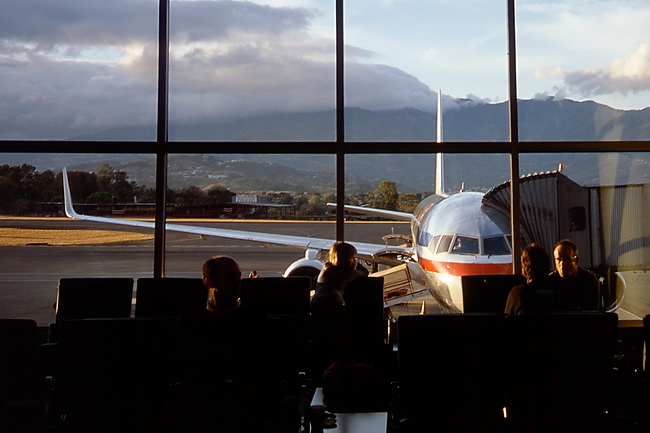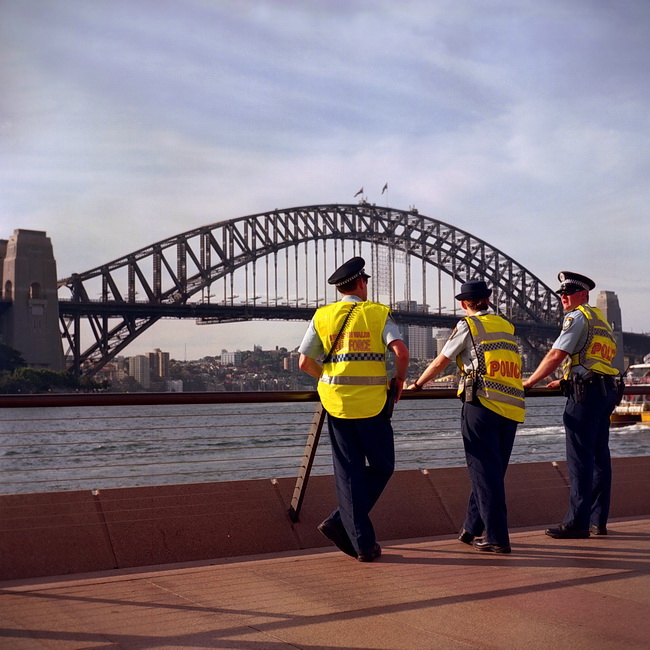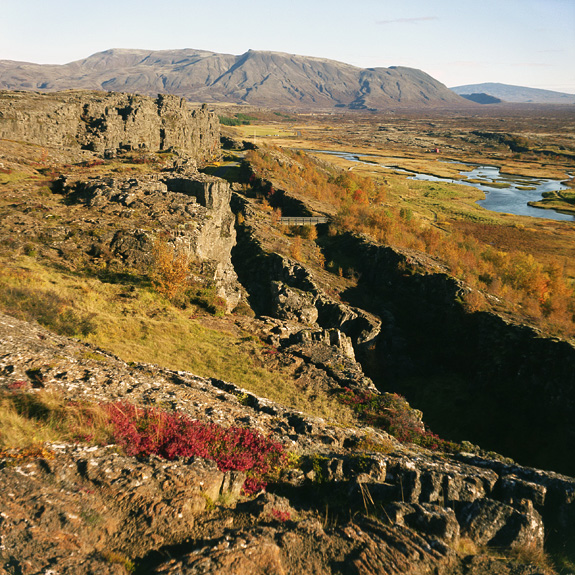
Juan Santamaria International Airport, San Jose, Costa Rica. (Camera: Olympus 35RC; Film: Fuji Provia 100F transparancy)
NOTE: This article has been significantly revised to reflect recent changes in airport scanning technology. You can read the revised version here. This older version is retained only for archival purposes.
Traveling photographers always worry about what might happen to their film when it’s time to go through airport security. And with good reason. X-ray scanners can fog film and ruin your hard-won photos. But how real is the danger, and what can be done to minimize the potential for harm?
Right off the top, let’s deal with the idea of just tossing your film in your checked baggage along with your socks and underwear. In the often confusing and contradictory world of air travel and film, the single point of universal agreement is that this is a bad idea. So, in a word, don’t. Airport screening in the U.S. follows guidelines issued by the Transportation Security Administration (TSA), and even they say, “Never place undeveloped film in your checked baggage, our security equipment used for screening checked baggage will damage your undeveloped film.” What more is there to add?
So our only practical option is to bring the film with us through airport security, and this is where the situation gets a little vague. Here’s the TSA’s take on the subject:
The X-ray machine that screens your carry-on baggage at the passenger security checkpoint will not affect undeveloped film under ASA/ISO 800.
But they also note:
If the same roll of film is exposed to X-ray inspections more than 5 times before it is developed, it is possible that damage may occur.
Air Canada makes the same points:
The equipment used for carry-on baggage at pre-board screening areas will not damage film with an ISO/ASA under 800. However, damage may occur if the same roll of film is exposed multiple times to a pre-board x-ray inspection.
If we parse these statements carefully, a couple of red flags go up. First, presumably, films with ISO ratings of 800 and greater should not be scanned even once. Second, repeated scanning is potentially harmful. Why? Because the effects of x-ray exposure are cumulative. Clearly the situation not as cut and dried as simply saying that anything under 800 is fine, anything over isn’t. Reading between the lines a bit, if a single scan is unwise for ISO 800 film, then it follows that two passes through the equipment (double the exposure) would be unsafe for ISO 400 film. Similarly, ISO 200 film should not go through more than four times and 100 speed film is in danger with eight scans. It’s almost impossible to avoid passing through security multiple times on a given journey, so clearly this is a concern.
A second consideration is what constitutes an acceptable amount of fogging? It’s not as if ISO 800 film is fogged into oblivion by one pass through the scanner, and ISO 400 is utterly unaffected — it’s a continuum. It all comes down to how much fogging are you prepared to accept in your photos? An amount that the TSA deems okay? Perhaps the TSA and other security operations have arrived at the ISO 800 number based on exhaustive testing and in-depth consultation with film manufacturers. But I doubt it. So what to do?
The safest course of action is to avoid having your film scanned at all, or at least, as few times as possible. Here are a few suggestions to help you accomplish that goal. First, keep your film in a clear plastic baggie that you can get at easily while in the security line up — just like you do with your liquids and gels. Screeners tend to be much more helpful if you make an effort to keep things moving along smoothly and don’t hold up your fellow passengers. Remember — they’re under intense pressure to get everyone through the system as quickly as possible. Anything you can do to help them achieve that goal will only help engender cooperation.
Second, be polite and prepared. I wait until it’s my turn to walk through the scanning arch, then, when I have the attention of the screener, I hold up my baggie of film and request a “hand check.” Those seem to be the magic words that security personal recognize and know how to respond to. “Please” and “thank you” are the other magic words, but then you knew that already, right?
Occasionally you’ll run into a screener who will rigidly apply the “under 800” guideline. That’s why I always include an expired, old roll of fast film in my baggie, so when they ask what kind of film I have, I can truthfully say “it’s a mix of different ISOs, including some fast film.”
What about special protective film bags? Don’t bother. Kodak succinctly describes the pitfalls: “The once popular lead-lined carry bags aren’t practical today because if an inspector can’t see through the bag, he will increase the intensity of the x-ray until he can. Therefore, film may receive more harmful radiation than it would otherwise if it were normally inspected.” Alternatively, the screener will probably just take your film out of the bag and run it through the machine anyway, but this time, in a slightly annoyed state because of the extra time and trouble it’s taking to process your carry-on stuff. See my previous note about making their lives easier.
Finally, if everything goes wrong and you run into a security worker who absolutely insists that your film be x-rayed even after you’ve expressed your concerns (politely, of course), don’t fight it. There’s nothing you can do at that point except get yourself into a world of trouble. If gentle persuasion didn’t work, angry insistence certainly won’t. In all likelihood, your film won’t be damaged by a single pass through the machine anyway. This is why I rarely fly with film faster than ISO 400. If my film gets scanned once or twice, it’s unlikely to be catastrophic.
Having said all of the above, I should add that I’ve traveled with film through dozens of airports both internationally and in the U.S. and Canada, and have never returned home with fogged film. The security staff I’ve encountered have, for the most part, been friendly and cooperative. Once in a while I even run into a screener who is also a fellow film user and is eager to chat. In my experience, such encounters are far more common than those wtih uncooperative security workers.
Unfortunately, every time I put a link in for the TSA’s guidelines, it dies. Their information on the subject seems to be something of a moving target. Your best bet is to go to their web site and perform a search for “camera film.”
Here’s what they are currently saying:
Undeveloped camera film is not prohibited, but you should only transport it in your carry-on baggage; the equipment used to screen checked baggage may damage undeveloped film.
If you are transporting high speed (800 ISO and higher) or specialty film, you may request to have it physically inspected when presented at the screening checkpoint instead of undergoing x-ray screening. You may also request that all of your undeveloped film be physically inspected instead of undergoing x-ray, particularly if your film has or may be screened by x-ray more than five times. To facilitate physical inspection, remove your undeveloped film from the canister and pack it in a clear plastic bag. We recommend leaving your film in the unopened manufacturer’s packaging.
In summary:
– Never put your film in a checked bag.
– Keep your film in a clear, plastic baggie and request a “hand check.”
– Avoid traveling with film faster than ISO 400.
– Include one roll of old, fast film in your supply.
– Be polite when dealing with security personnel.
Happy travels!
(Did you find this article interesting or helpful? If so, consider using this link the next time you shop at Amazon.com. Better yet, bookmark it for future use. Thanks to Amazon’s associates program, doing so costs you nothing yet helps keep this site up and running. Thanks!)

 Subscribe with RSS
Subscribe with RSS









Nice advice… I was about to take some film either in a older lead-lined bag or get something newer, but the Kodak logic seems right… Didn’t know they could crank up the radiation at will. My solution at the moment will be to maybe bring a few rolls and mail-deliver the bulk to the first hotel. After multiple-stops in a week by car, I’ll mail the shot film out to the labs or to home and fly filmless on the return trip, just carrying the digital shots with me. Larger format film is too expensive and film in general is, for me, a intensive effort on the shots I take, to risk fogging.
Bob:
Some people dispute that screeners can “crank up the radiation at will,” but as I said in the article, even if they can’t, they will probably regard the mystery blob of your film bag as something that needs additional inspection, which might mean emptying its contents and running them through the machine anyway.
Gary
I am going on a trip this summe and was planning to take around ten rolls of film. After reading this article I was wondering if my film woul be affected at all. I shoot 200/400 speed film and the film would be in my suitcase( not carry on) on the way there and the way back.
Hi Gavin:
As I emphasized above, the one thing just about everyone agrees upon is that putting film in your checked bag is a bad idea. I wouldn’t do it once, let alone twice. Film with ISO of 200 or 400 will probably be okay as carry-on, so long as you don’t put it through scanners too many times.
Gary
If possible, I mail my film home. It’s an inconvenience but if you want to be sure…
Max,
Everything that is mailed is inspected by X-Ray and will not control the way the inspection is done.
I prefer to take the films with me and to act like is advised in this excellent article. Taking the films with you, you will have some control how they are inspected.
Clarified a lot of issues for me regarding traveling with film. Learned to take the film through carry-on, smile and ask for a “hand check” regardless of the ASA and be sure to have the film in a TSA approved size baggie to expedite the process. I never travel with film over an ASA of 400, so should be in good shape. Thanks for taking the time to put this info together!
Thank you so much for these tips! This is really helpful!
Can an older camera without film be packed in check-bag & take a new roll of film in my purse, carry-on?
Sure. The camera isn’t the issue, it’s only the film that’s potentially harmed.
Thank you for the advice, I hadn’t even realised that this was an issue. Last year I put a 200 iso film into a bag that went into the baggage hold and thankfully it was absolutely fine! I wouldn’t have done it if I’d known this though, sounds like I was lucky. It was on a flight from Bucharest to London so perhaps the Romanians aren’t as stringent with the scanners as they are in America.
I suppose this affects film that hasn’t been exposed as well?
Yes.
I found following on the official website from Heathrow Airport
* These films will be visually unaffected by up to eight and in some cases 32 passes through the hand-luggage x-ray machines. Processed film can be x-rayed virtually without limit, without suffering any ill effects whatsoever from these machines.
What is meant by processed film? I suppose exposed film? In this case there is no danger, is this correct?
Processed film = film that’s already been developed. Exposed that hasn’t been developed would be in trouble.
Thanks for this, a very helpful article.
Does your ‘suitcase’ get scanned? I wasn’t planning on taking any luggage on board with me therefore keeping it in the main storage of the plane.
Is this at risk at all? I’m going to be going through Iceland/ Alaska/ Canada then back to the UK via airports, so the film will be scanned multiple times if they do scan non ‘hand-luggage’
Many thanks!
All luggage gets scanned, which is why I recommend asking for a hand check of your film. Re-read paragraph #2.
“To facilitate physical inspection, remove your undeveloped film from the canister and pack it in a clear plastic bag. We recommend leaving your film in the unopened manufacturer’s packaging.”
this statement seems contradictory. do I remove it from the box and cannister? or leave the unopened box?
Only the TSA can say for sure. I just leave it in the unopened box. If they want to take it out the box, they can. Sometimes they do, sometimes they don’t.
What about scanning film that is in a camera? Would that pose a problem?
I don’t think the camera offers much protection, so it would be affected to the same extent as a roll of film in its box.
I am going to be going to Australia soon. I will have with me both iso 200 & 400 35mm film as well as iso 800 instant film. Will unused packs of the instant film be okay through security? Also, with the 35, I assume it will be okay on both the way there and the way back if it is scanned twice on the way there and twice on the way back.
I would request hand checks of all your film. I don’t see an upside to taking a chance — especially with the instant film.
Pingback: 52 Photo Tips #15: Don’t put film in hold luggage | Zorki Photo
hi,
thanks for the usefull and interesting advice.
I am travelling from the mainland Europe to Edinburgh, UK. Following text can be found on the Airport security website:
“Specialist film (ISO 800 and above) under exceptional circumstances, when passed more than eight times through the hand-luggage security scanning machines, can be affected. However, the nature of the change occurring is barely noticeable to the naked eye and indeed does not become clearly visible until film is exposed around 32 times.”
further stated:
“Hand search requests for professional film will normally be accommodated, but the final decision in all individual cases will always rest with the on-duty security supervisor.”
So if I can believe this website it would take a ISO 102800 film to get only “barely visible effect”. I’ll spare you and myself the calculation to 32 times.
However this will not hold me back to still ask for a hand check!
Hi fellow film enthusiasts,
I’ve been traveling Europe for about 4 1/2 months now and brought 20 rolls of Kodak Portra 400 with me on my travels. I hadn’t done any prior research to my trip and all of my rolls have been on about five flights total inside my checked-in luggage. Upon doing some research and still currently traveling, I’m worried all of my film is going to be fried when I get them developed.
I realize it’s completely my fault but I’m hoping atleast some of the film is still salvagable.
Has anyone had any experience dealing with film that has gone through checked-in luggage x-rays?
Thanks,
Zac
Hello!
I’m taking my Nikon F4 and a lot of Portra, even some 160vc, I’m afraid they’ll check the film inside my camera. There’s a roll of Portra in there currently and I leave next week, should I try wind it out and attempt to leave the leader out or should I keep it in there and hope they don’t ask to inspect it?
Thanks,
Ross
Hey, Zac,
what happened with your filme? Did you already developed?
The same happened to me! I traveled with my undeveloped filme on my checked in luggage and now I’m afraid I lost it 🙁
I will know the result next month.
I hope i’ll be lucky.
hah good luck for you too!
An extreme solutions with black and white film would be that you could bring the chemicals (in the allowed amounts) to process it at your place of stay. Of course that doesn’t help undeveloped film.
Anyone know of these effects are more or less impactful on Polaroid 600 film?
If you are using instant film, especially the ones form Impossible-Project, the following link may be interesting:
https://impossible.zendesk.com/hc/en-us/articles/216750328-How-to-travel-with-Impossible-film-
They recommend to remove all film from the checked baggage and to place it in the carry-on baggage. And processed film will be unaffected by x-rays.
However, I think, that heavy x-ray influence still may impact the processed instant films.
=> Has anybody experience with processed instant films (from Impossible Project)?
Thanks!
At US airports the hand search is a nice option. Of cause it might be more difficult if you shoot sheet film (4×5″ and larger), because they come in a paper box in which you could hide anything and if you open the paper, the films are exposed. So there is only the x-ray.
In Europe you can forget hand search completely. They will insist on the x-ray. I never had any problems with my films (mostly ISO100, sometimes Tri-X 400 and Portra 400) so I do not worry to much.
But in general I would not really worry anyhow. If I travel to some place in the USA, I have my hotel adress a few days before I get there so two or three days before I get there, I make a mail order from Adorama or B&H and it will be there a day after my arrival.
In Germany there is Fotoimpex who send out the goods within the following day latest and German post usually works overnight.
As long as you stay within countries like the USA, Canada, western and central European countries or Japan, Hongkong, etc. there is zero problem to get the film locally. If you use C-41 films you can even get the developed without any problem before you fly home.
I have been travelling with sheet film for 30 yrs and rarely had a problem with fog, because I packed it in a lead case, maybe just a little at times depending on how many times I went through security checks, but the fog would be slight and over the whole surface, and I could print through this ‘base fog’…BUT for the first time yesterday I had a serious problem, which I thought I should share. When I flew to a distant location I packed my 4×5 in a lead envelope as usual…unexposed. To my dismay when I personally developed my film locally, the whole pack of film had a serious exposed band about 1 cm all the way across the surface, and all the way through it, at exactly the same spot. At first I thought it might be me, camera?bellows?lens? Nope! When I developed a sheet from the brand new unexposed package, it too had the band and I could see another slight band at the top of the sheet also. I know for a fact that a new generation of scanning equipment is in operation in airports and these are VERY powerful…my error was too pack my film in lead, because when the scanner cannot see through it, a second more powerful burst of X-Rays is sent and that one destroys everything! Including passengers and the poor security official believing what he is told and spending days on end sending bursts of X-Rays or Gama Rays at this point!
If there is a moral to this story, I think the best thing would be to ship the film directly from a reputable photo/film supplier via a trustworthy carrier eg Fed Ex…but to inquire with both if this is possible and what security checks the film will go through….
I hope this little piece of advice might prove useful…and I wish you all the best to all you Film Lovers out there. When there is a will, there is a way!
Thanks for the helpful article.
In your experience, will security personnel inspect a camera containing partially exposed but undeveloped film? Or does the camera itself need to go through the X-ray scanner (as I would expect they would insist on, given it’s an electro-mechanical device). In this case, I assume the guidance would be to rewind partially exposed rolls and have them hand checked.
I’ve travelled on one trip with undeveloped rolls of Ilford Delta 3200, which were scanned at least 2-3 times going through airports. I didn’t notice any fogging in that case, but I will try to have my film hand checked in the future.
Will they hand check your camera as well? I have a roll in my camera currently and I haven’t even shot half of it yet! Luckily it’s only ASA 400.
I’m curious..I have a film from the 40’same I believe. I will be traveling from Seattle to Las Vegas soon. I want to take it with me to have it looked at by a German History buff. The film is a 9.2mm Austrian tape. Will it be safe to travel with?
I find this topic quite interesting as I was planning on travelling with film, but I guess I’ll just develop it before getting on the plane. Question though: so how do film rolls come to Europe and other continents without being damaged? I suppose the cargo shipments get scanned as well? Interested to know.
I recently bought a nikon FE2 (used but in great condition). I took a trip from Victoria -> Cabo ->Toronto -> Victoria so I went through 3 carry on scanners with it. When I tried to get the film developed they told me it wouldn’t work and suggested it could have been the x-rays. Looking at the film there are no frames or anything, just a foggy wave going horizontally across the whole strip. Could the xrays be that damaging? or does this sound more like a user/camera error?
Hi Ezra, sounds like X-Ray damage as shown on Kodak Website.
https://www.kodak.com/global/en/service/tib/tib5201.shtml
Thanks for the valuable info.
I have a canon AE1 camera and will be travelling out of the country with it. I’m wondering if the film in my camera is safe? I would hate to waste a roll of film (I’ve only taken 3/24 exposures) What is the procedure for checking film cameras?
Hi: two things; 1) politeness is not the same in the whole world. There are countries where they are even more paranoiac at airports or checkpoints than others. I agreed with all that you said here, but if for any reason at check screen security you insist to explain why you ask for a hand check in some countries, they will be refusing to do so until you´re dead. I am mexican, and in México authorities don´t give a shit about politeness, sad but true.
2) I am a 40 years experienced photographer (ten of them spent as a photojournalist in old times not digital) who had traveled quite a few thousand miles, and to say something extra to a more relax extent, I would tell you for sure, that I even traveled wit ISO 3200 and nothing happens not even noticed change in the quality end when my film were developed.
As shit happens, sometimes even miracles also happens. 🙂
Possibly a silly question but … does this apply to all film, whether it has been exposed or not ? Is the film at risk before I even shoot any pictures ? I’m doubtful whether I can buy and/or process 120 film in some countries I’m planning to visit so I’m trying to understand the risk !
Yes, exposed or unexposed film face the same kinds of risks. The only kind that isn’t at risk is film that’s been developed.
Hi; this is a very useful article. Thank you for posting it.
Sorry if I missed the answer for what I’m about to ask; I checked also other articles.
I know that unprocessed film is at risk, but I’ve read that exposed film is even more sensitive than unexposed one. I’ve also read about the number of times that a film could be scanned without expecting damage: like around 4 or 5 times for ISO400 film, for example. What is the number to expect when the film is exposed? Half that of the unexposed?
http://www.thephoblographer.com/wp-content/uploads/2014/01/Chris-Gampat-The-Phoblographer-TSA-Travelling-with-film-1-of-1ISO-4261-30-sec-at-f-2.4.jpg